
Paratext and the world of a work in public space: Eisenbach and Mansur’s Placeholders
by SEAN LOWRY
- View Sean Lowry's Biography
Sean Lowry is a Sydney-based visual artist, musician and writer, Convener of Creative and Performing Arts in the School of Creative Arts at the University of Newcastle.
Paratext and the world of a work in public space: Eisenbach and Mansur’s Placeholders
Sean Lowry
This text will explore ways in which some artists working in public space seek to communicate concurrently with both art literate and broader community audiences. The task of simultaneously meeting diverse audience expectations is complex, and as this text will demonstrate, its success is typically dependent upon the supporting function of paratextual materials. The challenge of seeking value and legitimisation in both a host community and an art world setting (whilst at the same time potentially meeting the expectations of university research agendas and funding bodies) can require artists to be conspicuously consultative and accessible in both project planning and during a work’s public presentation. Moreover, meeting these diverse expectations can sometimes involve producing a world of supplementary materials. These materials, although potentially inclusive of broader currencies of attention, can invite very different interpretations from art-literate audiences. In some instances, supplementary materials are perceived as enriching and extending an audience’s experience of an artwork. In other cases, they can be seen as overtly prescriptive or didactic and therefore as potentially limiting an audience’s experience. It is therefore important that supplementary materials are designed to perform a complementary function within the world of a work. Within the context of this discussion, the term world of a work is used to describe to way in which actions and artefacts presented by artists might be understood as continuous with the surrounding contexts they both inhabit and implicate. This paper will explore ways in which the strategic inclusion of supplementary elements accompanying a work presented in public space might serve to enhance the experience of the work for both art and non-art literate audiences.
The case study used to explore these ideas is Placeholders—a site-specific and site-inspired work produced as part of an ongoing interdisciplinary collaboration between architect Ronit Eisenbach and dance artist Sharon Mansur, and first performed in the Long Branch neighbourhood of Silver Spring, Maryland on September 13, 2014. Long Branch is home to an increasingly diverse immigrant community in which plans for a new metro stop are creating concerns that development will affect housing affordability. Placeholders was intended to highlight the value of place in forming and maintaining community. In preparation for this public event, Eisenbach and Mansur spent two years researching and building relationships in the community. Then, in order to both frame and augment its public presentation, they utilised leaflets printed in English and Spanish together with bilingual guides, props, costumes, temporary markings, and a soundtrack. From a well-publicised starting location and time, volunteers guided the audience between three locations in a community-shopping district to experience a choreographed dance-based performance that playfully animated footpaths, traffic meridians and crossings using chairs, ladders and tables to caricature everyday functions. Temporary markings and wooden staffs complemented the choreographed movements. Meanwhile, a composition that integrated on-site audio was amplified via portable soundboxes and stereos in parked cars. After the performance, the audience was invited to temporarily mark pathways in the final location (a park containing a children’s playground). Significantly, these approaches appeared to both invite a broader non-art literate community into the world of the work, and to introduce additional layers and complexities into an art-literate audience’s experience of the work.
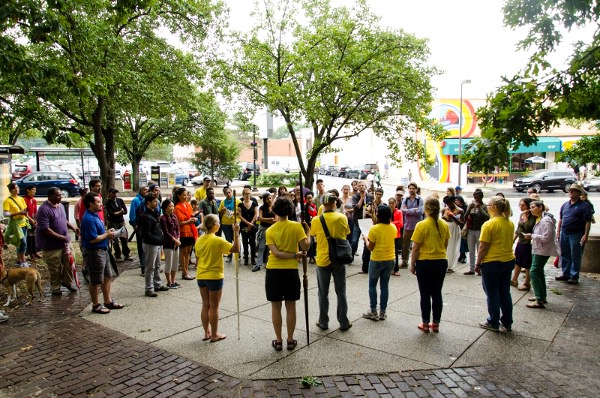
Bilingual guides prepare the audience prior to the performance. Ronit Eisenbach and Sharon Mansur, Placeholders, 2014. (Photograph by Zachary Z. Handler, copyright Eisenbach and Mansur)
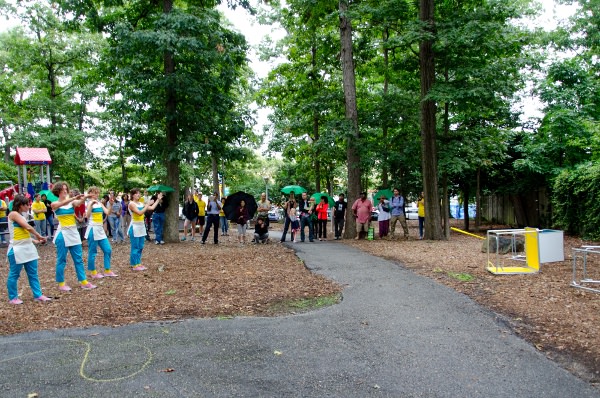
The quartet of dancers activates Flower Avenue Urban Park. Ronit Eisenbach and Sharon Mansur, Placeholders, 2014. (Photograph by Zachary Z. Handler, copyright Eisenbach and Mansur)
What, where and when?
The problem of defining the what, where and when of a work of art presented outside a traditional exhibition environment inevitably extends toward consideration of that which might otherwise be perceived as existing at or beyond the work’s ‘borders’. For art-literate audiences (primed to read works as absorbing and dynamically responding to host environments), this inevitability arises via a learned assumption that interpretation of art in public spaces typically involves consideration of elements operating at a work’s margins (i.e. the points at which the work meets the continuum of everyday reality). For broader audiences, certain elements (such as a work’s physical and cultural context) are sometimes only meaningfully activated when pointed to through the use of supplementary materials. Complicating the picture further, once the everyday functions of a host community are brought into the world of a work they can problematically assume a doubled ontological status––insofar as they are now potentially seen as being at once art and as something serving a function in another social category (Bishop 2012, 45). This is further complicated (such as in the case with a project such as Placeholders) if certain elements are simultaneously regarded as part of a socially motivated community awareness initiative, a university research project, everyday life in that community, and a work of art. On one hand, the paratextual materials can function to invite the attention and participation of non-art world audiences and stakeholders. On the other hand, for art-literate audiences, they can potentially introduce both a richly expanded intermediality and a prescriptive readability.
What exactly do we mean when we refer to the role of supplementary materials in the world of a work? Paratext is a concept used in literary interpretation to describe the way in which supplementary materials surrounding a text (such as cover design, preface information, formatting and typography) can alter interpretation of the central text. Paratexts therefore both speak to and help create a broader cultural and historical context for a work. They also form a fundamental transactional threshold between text and non-text (Genette 1997, 2). Within the context of the visual arts, Joseph Grigely has coined the term “exhibition prosthetics” to describe the way that supplementary materials live concurrently inside and outside a work. Grigley is referring to the meaning-making role performed by background information, documentations, representations, and other materials operating at the fringes and margins of a work. As part of this conception we might also consider Jacques Derrida’s concept of the “parergon”—a concept describing elements that at first glance might appear to be an external supplement but actually form an essential part of how we experience a work (Derrida 1979, 20). Considered together, these tools provide useful ways of describing art’s often-omnivorous appetite for everything at its margins (being at once a critical and complicit mirror of capitalism’s parallel appetite).
Paratexts potentially play a different kind of role in relation to artworks presented outside of traditional exhibition environments. Unlike a work presented in a museum or gallery context, where it might be self-apparent that the viewer is in the presence of art, many contemporary artworks presented in public space need to be explicitly “pointed to” in order to exceed arbitrariness. But there is also another interesting thing that happens when paratextual elements are used in non-traditional exhibition environments. Given that the host environment generally offers specific textures to the meaning-making matrix of the work, it can quickly become difficult to determine precisely what is the work and what is not the work. Consequently, the blurred boundary between work and not work can potentially play a more significant role in interpreting the work. Often via the pointing capabilities of paratextual elements, this blurred boundary therefore becomes an increasingly important part of the expanding world of the work. By extension, it becomes relatively easier to see paratextual elements as a legitimate part of the work itself.
For an artwork to be perceived as meaningfully existing, it is clear that ‘something’ needs to be made conspicuously present, and in being perceived as present, frames a transactional space between artist and audience. At the very least, this perceivable ‘something’ ensures that a creative work presented ‘in the field’ (outside traditional exhibition circuits) might exceed arbitrariness. In this context, Jacques Rancière has usefully pointed to the role of a “mediating object” as something that performs the role of both availing and negotiating the necessarily distinct experiences of artist and audience (Rancière 2012, 133)). Building upon this idea, Claire Bishop has pointed to a “mediating third term” in which a publically perceptual object such as “an object, image, story, film, even a spectacle […] permits this experience to have a purchase on the public imaginary” (Bishop 2012, 45).
Experiencing an artwork clearly requires audience recognition of at least one medial ingredient. As Ilmar Taimre has neatly put it, an artwork “is none other than the experiential meaning which emerges, in the mind of perceivers (artists and audience), as the product of a translation process (or experience) involving at least two semiotic systems, and the perception of one or more publicly perceivable objects” (Taimre 2016). This “public perceptual object” (Strayer 2007, 3) is a “vehicular medium” (Davies 2004, 59) that can potentially assume the form of anything from a physical artefact to a performed gesture, text, site, or an imaginary or virtual object. Once an artwork presented through the medium of community possesses the currency of attention (i.e. it has exceeded arbitrariness), it can then meaningfully activate and consume surrounding content and happenstance. Yet once this surrounding content and happenstance becomes part of the world of the work, it can quickly become unclear as to exactly which elements should meaningfully inform an experience and evaluation of the work. Do elements positioned at the margins of a work simply function to extend the work’s ontological reach beyond art and toward that which is then potentially attributable to other socially defined categories (such as community awareness or university research)? Given that social categories are inherently fuzzy, it can be fascinatingly and frustratingly difficult to meaningfully distinguish that which is inside and outside the world of the work (a world, which in the case of Placeholders, is already an aggregate of choreography, expanded architectural delineations, and general happenstance in a community-shopping precinct). This (particularly for a non-art literate audience) is where the role of paratext as a pointing device becomes particularly important. Although Placeholders clearly sought validity through being positioned within the language of contemporary art, it also aimed to be seen as engendering a broader engagement with the future of the Long Reach community in the face of the imminent construction of the new Purple Line light-rail stop. Can art have it both ways, and if so, can supplementary materials concurrently perform different roles?
For Claire Bishop, much socially-activated contemporary art straddles an uncomfortably doubled ontological existence insofar as it routinely claims to be at once art and something else (such as an event, protest, research activity, conversation, lived experience etc.). On one hand, this double dipping potentially implicates this kind of art as always in danger of either retreating into the specialised rhetoric used to frame it to an art-literate audience, and consequently of contradicting any broadly inclusive ethos that it purports to promote. On the other hand, it enables a work to defer or evade aesthetic judgment in the name of more easily morally justifiable values such as of community awareness or good politics. A common criticism of much art presented in public space (despite its typically inclusive rhetoric), is that it serves the interests of a closed circuit of artists and academics as opposed to the community in which it is created. It is obviously difficult to defensibly distinguish contemporary art’s appetite for that which is not yet art from the potential value of embedding community awareness and good politics in an artwork. Surely we cannot decry this relativist quagmire when we want to exercise aesthetic judgment whilst at the same time delighting in crossing boundaries. Either way, paratextual materials are signposts at the margins of the world of a work, which are at once capable of pointing the way into the work for a non-art literate audience, and toward the outermost limits of the work for an art literate audience.
Artists have long been concerned with pointing towards that which might otherwise go unnoticed. For both art-literate and broader audiences, much contemporary art can potentially remain unnoticed unless explicitly pointed to. This task of pointing is particularly difficult when it no longer necessarily makes sense to pinpoint a single fixed and immovable object, location or moment as the “thing” of the work. Given that we cannot even begin to behold a work before it has drawn our attention, a work’s initiatory “vehicular medium” (Davies 2004, 59) can potentially be anything that directs contemplation and interpretation toward the world of the work. In many cases, our first encounter with the world of a work is via paratextual materials. Although “fuller” comprehension might typically demand some combination of direct experience and contextualising information, a work such as Placeholders is potentially accessible on many levels. These distinctions are also not necessarily easily reducible to dichotomies such as art-literate versus broader audience or direct versus mediated experience. Any understandings built in the mind by someone who has read about but not directly experienced Placeholders might represent partial evidence for this claim. Also, being an interdisciplinary work developed in collaboration between an architect and dance-artist, Placeholders is potentially a profoundly different work for audiences more or less versed in the specific languages of dance, architecture or social practice. Irrespective of whether paratextual materials meaningfully illuminate or irritatingly prescribe possible audience interpretations, it is nonetheless apparent that their inclusion can substantially alter an audience’s experience of works presented outside traditional exhibition environments.
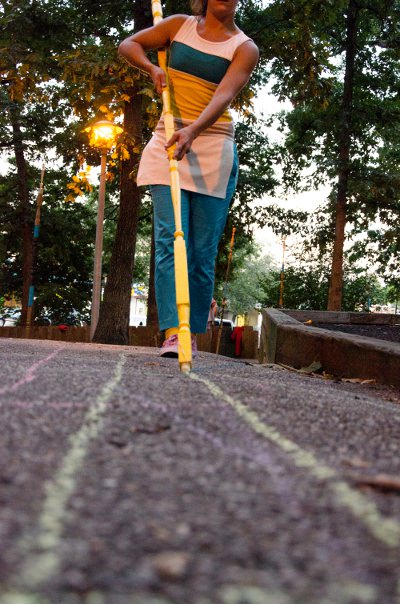
Ronit Eisenbach and Sharon Mansur, Placeholders, 2014. (Photograph by Zachary Z. Handler, copyright Eisenbach and Mansur)
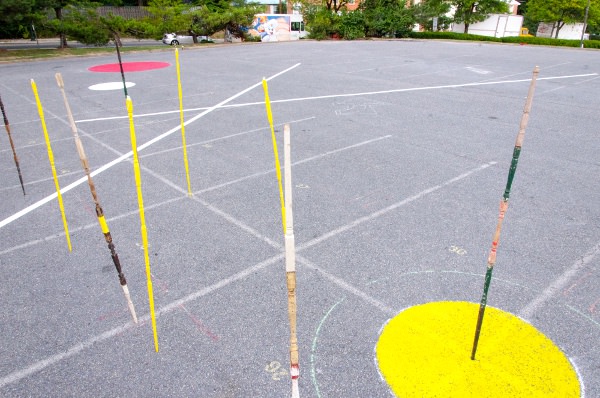
Ronit Eisenbach and Sharon Mansur, Placeholders, 2014. (Photograph by Zachary Z. Handler, copyright Eisenbach and Mansur)
Given that contemporary artworks are routinely framed and understood as dynamic omnivorous entities with a penchant for absorbing elements from other cultural categories, we are still left with the potentially unanswerable question as to which particular elements should be meaningfully included in an evaluation of an experience of a work such as Placeholders. And, by extension, we are also left with a related question: what are the minimal ingredients required to meaningfully respond to an idea framed as art? Are paratextual elements, when considered in isolation, capable of producing anything resembling an experience of a work, and if so, do they therefore form an intrinsic part of the world of the work?
Thinking about an artwork as something made accessible via a constellation of elements (including text objects) is now a well-established idea. Art historian Rosalind Krauss has offered the term “post-medium condition” to describe a rethinking of the idea of an artistic “medium as an aggregative ‘network’ or ‘complex’ of media” (Krauss 2000, 56). The task of interpreting a work such as Placeholders is therefore linked to a process of taking stock of a dynamic (and not necessarily all present in any given moment) aggregate of complex interrelated intermedial components. For Placeholders, this process would typically begin in advance of the physical event via paratextual materials (being in themselves a requisite part of knowing where and when the physical event takes place). This process of interpretation would then continue via a series of encounters with material and formal elements of the physical performance itself, which lasted just under one hour in a sequence of three parts within the vicinity of a couple of blocks in the Long Branch neighbourhood of Silver Spring.
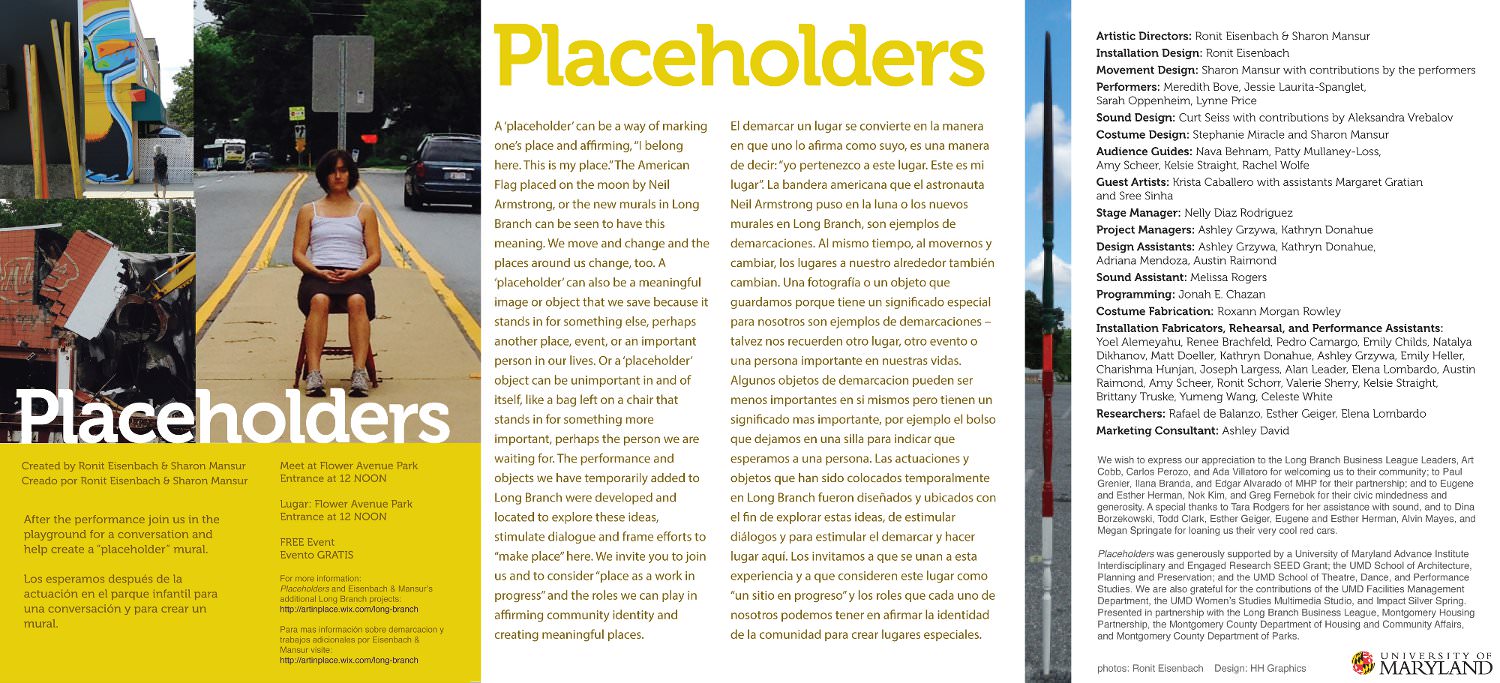
Ronit Eisenbach and Sharon Mansur, Example of bilingual materials disseminated in advance of event (Photographs by Ronit Eisenbach, Design HH Graphics)
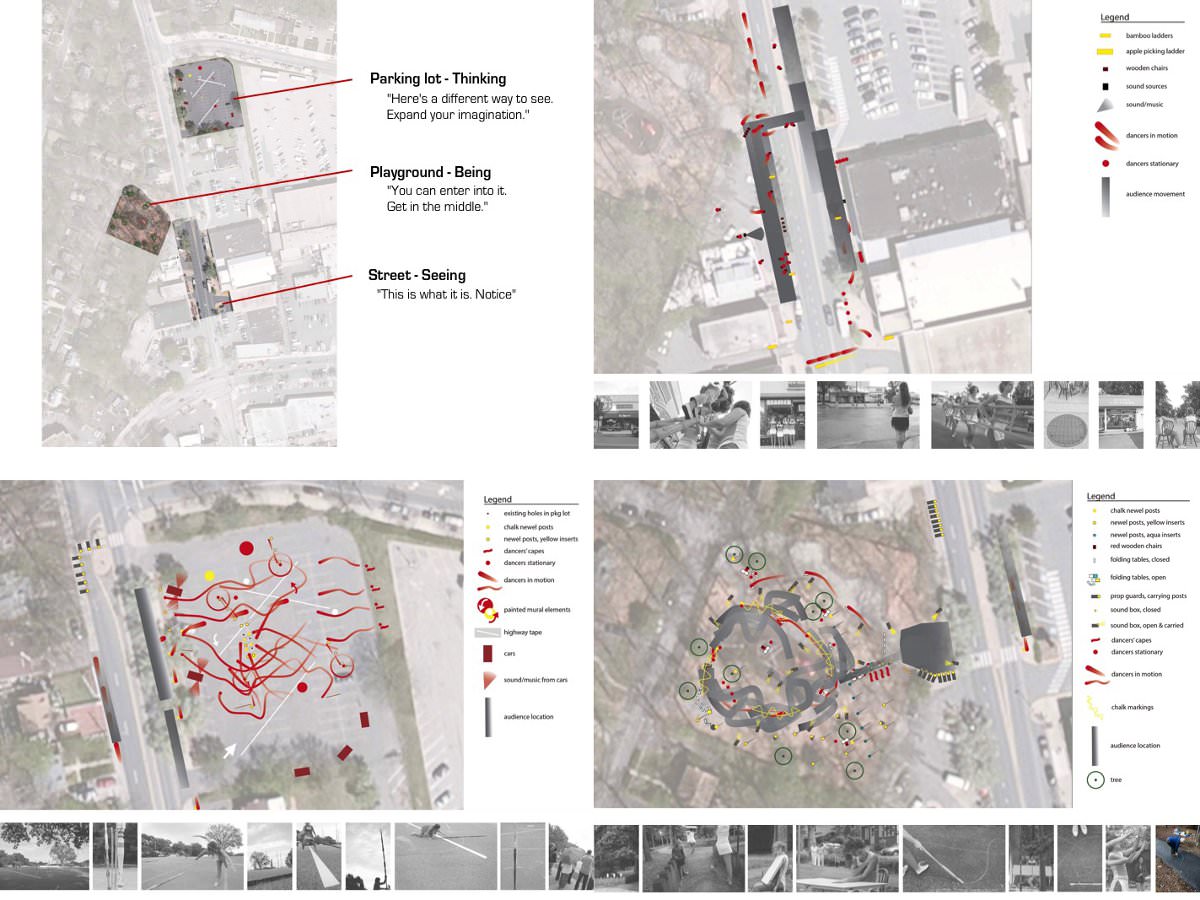
Map overview and detail three performance locations, props and movements (Kathryn Donahue and Ronit Eisenbach)
Paratextual materials were also an integral part of successfully pointing the audience to each part of the physical event. From an advertised starting location and time, the audience was invited to walk to the three locations in succession. The first part of the event took place on a stretch of sidewalk adjacent to a series of storefronts. The second took place in an empty parking lot bound by a sidewalk that became a proscenium edge for a stage delineated by markings and wooden staffs. The third took place across the street in a children’s playground. Augmented by explanatory guidance from volunteers, together with sound and props, the performance comprised both a choreographed quartet of performers and the participation of a largely community-based audience. Choreography and supplementary props such as chairs, ladders and tables were used to caricature (and therefore point to) everyday movements and functions taking place around them. The performers animated public sidewalks, traffic meridians and crosswalks whilst reiterating and responding to the actions and functions of local people and businesses. A soundtrack, which integrated on-site audio recordings, was amplified via portable soundboxes and stereos in strategically parked cars in each of the performance locations. Temporary markings on the ground of the parking lot and wooden staffs deployed to augment and extend performed gestures, and with the consistent help of explanatory guidance, bring the community audience into the work. Echoing Derrida’s notion of the “parergon,” many elements that might otherwise be seen as supplementary clearly played an important mediatory role. In this sense, these elements should all be considered as part of an aggregate formation of perceptual objects contributing to the meaning-making matrix that is the work.
A central part of the task of interpreting a work presented within the context of a community is an assessment of its relationship to a participating “community as medium” (Bishop 2012, 45). Broadly defined, a community is a socially organised unit that shares values and/or place. A place-based community is bound together through a geographical location in which people live, work or spend time. Key elements in creating a sense of community include membership, influence, integration and fulfilment of needs, and a shared emotional connection (Chavis and McMillan 1986, 16). It is important to remember that artists and broader communities do not exist in binary relationships. Artists are part of broader communities that collectively create the requisite cultural conditions within which artists can work. Just as there is no community without individuals, individuals require a community in order to construct meaning. Like any community, the ‘art world’ is a collectively generated and dynamic social construction predicated upon a group of peers offering a receptive arena within which to act. Furthermore, artistic collaborations are in themselves communities. Artworks do not arrive in the world autonomously. They are dependent upon pre-existing networks of communal relations. Eisenbach and Mansur’s Placeholders can therefore be understood as both community building and community dependent. Without the creation of a community of collaborators and the existence of a host community, the work could not have been brought to fruition. Together with performers Meredith Bove, Jessie Laurita-Spanglet, Sarah Oppenheim and Lynne Price, the audience was guided to each of the three locations by a volunteer team of bilingual guides (especially important given that this wasn’t a conventional way of navigating the neighbourhood). The audience guides, who were clearly recognisable in yellow t-shirts and carrying wooden staffs, performed an essential transitional role in-between the audience and the dancers—and in doing so, brought both parties together within the world of the work. This transitional role extended the paratextual function of printed materials to assert the spatial and sequential structure of the work.
Echoing Henri Lefebvre’s famous articulation of the street as a place to play and learn (Lefebvre 2003, 18), or Kenneth Goldsmith’s recent rearticulation of the value of the historical avant-garde technique of psychogeography to help mark places where one has felt joy or sadness (Goldsmith 2001, 37), Placeholders responded to both the emotional flows of the neighbourhood and its imposed rational grid. In this sense, anything that functioned to bring community into the work, and by extension the community itself, then became part of the work. Although Eisenbach and Mansur clearly had a sense of the kind of work it would be, the dynamic site-responsive nature of staging a work within the medium of community certainly left plenty to chance. Transactions continued to take place in stores. People continued to walk by. Children continued to play in the park. These elements, which were all potentially invited into the work via the inclusively worded bilingual information, worked to highlight both existing physical features of the built environment and the happenstance of community. At one key point during the second part of the performance, a horn from a pre-recorded passing car in composer Curt Seiss’ accompanying soundtrack echoed a car passing in real time. This chance event produced laughter, which also helped bring audience and guides together in an experience of the work
Like much contemporary art presented outside traditional exhibition environments, Placeholders consisted of materials and actions that were presented as being at once continuous with everyday lived reality and socially framed as art. This doubling is simply an extension of the long established way in which artists use representational logic to offer a fictional double of social constructions. But in order to function as art in this sense, audience recognition of concurrently literal and latent meanings becomes necessary. Once art is taken out of a traditional exhibition environment, and especially if presented without an explanatory framework, it can be difficult to exceed arbitrariness. To this end, paratextual materials can assist in the task of making connections to form the world of the work.
Place making
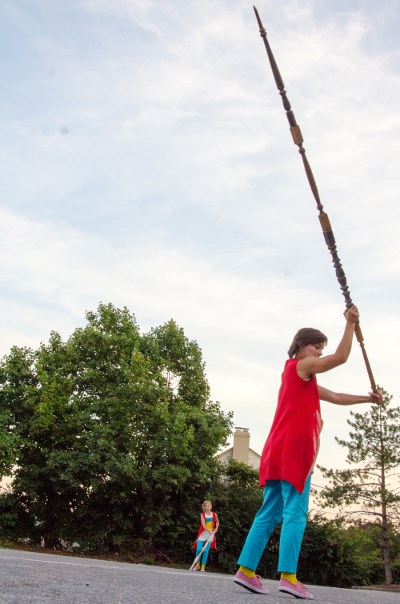
Ronit Eisenbach and Sharon Mansur, Placeholders, 2014. (Photograph by Zachary Z. Handler, copyright Eisenbach and Mansur)
From children’s playgrounds to nation states, socially defined delineations of place are dynamic and temporary. Moreover, they exist to the extent that people believe that they do. Unlike space, which possesses abstract physical and formal properties within the continuum of physical reality, the value of place is socially constructed (Tuan, 1977, p. 6). This value can therefore easily shift or disappear together with the community that ascribed its value. Against this backdrop of inevitable change, art can perform a mnemonic and transitive role. This role is perhaps more apparent when artworks are experienced as dynamic constellations of elements rather than presented as ossified objects. With movement in mind, “place” (when used as a verb) also denotes the action of setting something in a particular location. Extending the twin meanings of “place” as action and location, a “placeholder” is an object, gesture or a marker of some kind temporarily placed as a stand-in for a location or idea. As was pointed out in the paratextual materials supplied by Eisenbach and Mansur, this might include anything from a personal item left to mind a space to a flag placed on a celestial object in the name of a terrestrial nation state. Artists are of course active participants in the practice of making placeholders. For Brooklyn-based artist Tariku Shiferaw, for example, a placeholder is a symbolic device within the language of painting. For Shiferaw, given that the mathematical symbol of “X” is an unknown variable until decoded (and redundant once decoded), it can be playfully used as a “temporary placeholder for an unknown variable” (Kukielski 2014).
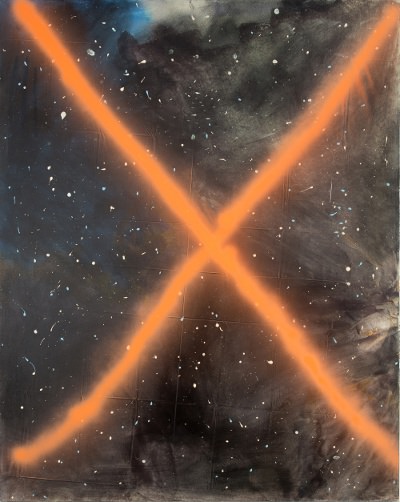
Tariku Shiferaw, Space-X 2015, Mixed Media, 152cmx 121cm (photograph by Niv Rosenberg, copyright courtesy Tariku Shiferaw)
Considered within the context of broader spans of history and deep time, all markers placed by human beings are likely temporary. Ultimately, the borders of nations, institutions and communities alike, together with the signs, objects and markers used to denote them, are artificial constructs used to delineate consensually imagined and socially defined entities. For some artists, it is in places undergoing rapid change where the illusion of permanence is most clearly revealed. Eisenbach and Mansur’s project experientially activated this illusion of permanence, and in doing so, gently invited community awareness of the gravity of incoming change in the Long Branch neighbourhood. Only paratextual ephemera, interpretations, and photographic or video documentations remain following a live performance event. Just as most contemporary artists did not directly experience the seminal historical performance works that underpin contemporary understandings, it is possible to build something of these works in our minds in knowing that they occurred through documentations and interpretations. Similarly, broader communities build a sense of place via documentations and interpretations of events long passed.
For artists such as Eisenbach and Mansur, events are something ingrained upon place, not as a literal object, but rather as a reconfiguring or reimagining of that place in collective memory. As part of a more generalised “social turn,” which Bishop describes as a “surge in artistic interest in collectivity, collaboration, and direct engagement with specific social constituencies” (Bishop 2006, 178), it is also claimed that places activated via performance and community participation might illuminate change and spark public discussion in a community. For Eisenbach and Mansur, a placeholder is a playfully ephemeral register for marking place and performing belonging. As discussed earlier, this is an idea that potentially resonates with both art-literate and broader audiences (the latter of course more specifically requiring supplementary materials in order to be brought into the world of the work). The sensorial textures and objects that Eisenbach and Mansur added or highlighted within the neighbourhood of Long Branch simultaneously performed two very different roles insofar as they were designed to both speculate upon intermedial possibilities in art making and stimulate dialogue around the notion of belonging in a demographically diverse and rapidly changing community. In this sense, Placeholders could be experienced as both an artwork and an implicit call to community engagement with development and change. For artist and community alike, place making is a register that one was “here.” Following the performance, the community were invited to use chalk and washable paint to mark the pathway in Flower Avenue Urban Park.
Paratexts connect artistic research, creativity, collaboration and community
For Eisenbach and Mansur, Placeholders was the culmination of two years of research and relationship development with key community figures and business owners. The project has also extended to several international research connections and partnerships. For Mansur, the project became increasingly interesting “the more we learned about the Purple Line development and the history of the community” (Mansur 2014). This issue would ultimately emerge as a key connecting thread in the project’s paratextual materials. In an interview with audience members following the event, Dina Borzekowski (a resident of nearby Takoma Park) was asked about the imminent construction of the Purple Line light-rail stop:
… [it] is a very accessible area, people who are immigrants or family who are moving there can afford to live there […] I’m worried that the PL will bring in the standards corporate [sic] and get rid of that homey feeling (Lombardo et al. 2014).
Other audience members interviewed after the event spoke more generally about how the performance had inspired them to rethink place-making relationships between community and space. It was clear that Placeholders had provided some local community members with a vehicle with which to discuss these issues. Long Branch resident Wendy Coulton, for example, revealed that Placeholders had inspired her to begin “thinking, this is the way it (the space) could be designed, this area needs an open space” (Coulton quoted in Lombardo et al. 2014). As paratextual materials supplied by Eisenbach and Mansur explained, Placeholders pointed to a place facing transformation, and in doing so, invited “community reflection upon what it means to preserve and generate place in the face of change” (Eisenbach and Mansur, 2014).
Consensual recognition of value is typically dependent upon activating networks of social relations. To this end, inclusively orientated supplementary materials can play an important mediating role in enabling art to activate networks of social relations. Like any cultural activity, art contributes to community building only if contributing parties feel meaningfully included in the process. A sense of connection to this process is related to the experience of participating in the marking of shared resources. Humans are social creatures, and creativity is produced (directly or indirectly) within arenas facilitated via social contact. Although much of the event was designed and choreographed, it was via interaction with the host community that its meaning-making potential was activated. Broadly speaking, works such as Placeholders are the product of a well-established emphasis upon the participatory value of audience reception and an open and inclusive process of collective interpretation. Placeholders clearly required networks of collaborators and community participation to be meaningfully activated. And, significantly, the participation of collaborators and community was dependent upon the inclusive use of paratextual materials. In order to be recognised as novel, a creative idea must first be recognised, in the words of psychologist Morris Stein, “as tenable or useful or satisfying by a group in some point in time” (Stein 1953, 311). In other words, criteria for assessment must predate reception. Artists have long played a role in helping to create a context for evaluating of their work. For Eisenbach and Mansur, the liberal dissemination of explanatory materials helped to create a context for experiencing the work.
Community, particularly in its overtly institutionalised forms, can present challenges for realising a work in public space. Public liability insurance, risk assessment, noise regulations, legal costs and licenses can all present barriers to artists seeking to activate public spaces. Again, explanatory materials can assist in the task of building a world of legitimisation. Over two years leading up to the event, Eisenbach and Mansur conducted extensive formal, sociological and phenomenological analyses of the site and engaged in extensive dialogue with various community stakeholders. This research produced a substantial amount of information that could then be used to effectively bring the community into the work. Without working consultatively with community stakeholders such as the Montgomery Housing Partnership and the Long Branch Business League, the project could not have been realised. Additional credibility was made possible following a successful proposal submission to Project Anywhere, “a global exhibition model for artistic research” (conceived by the author) that “endorses the type of peer review model typically endorsed by a refereed journal” (Project Anywhere, 2016). Despite the localised focus of Placeholders, it is interesting to take stock of the networks of international partners and collaborators implicated in some way in the world of the work. This text serves as another example of the role of explanatory materials in both giving rise to and extending a work across space and time.
In conclusion
The city fosters art and is art; the city creates the theater and is the theater (Mumford 97).
Much contemporary artistic activity is now conducted and understood in relationship with a discursive and expanded field of public space and the idea of community as medium. Given the often ephemeral nature of this kind of work, and given its relative isolation from traditional institutional exhibition circuits, artistic activities in public space typically require at least some degree of paratextual support to be meaningfully recognised and experienced by a non-art literate audience. Eisenbach and Mansur’s use of bilingual information, guides, pointers and various framing devices both in advance of and during Placeholders worked effectively as strategies for inviting non art-world publics into consideration in their use of public space. Meanwhile, for an art literate audience, the strategic inclusion of paratextual elements served to speculatively problematise the margins of the work, and in doing so, to effectively invite happenstance into the world of the work.
Art is routinely experienced through both direct sense perception and supplementary and documentary materials. Even without necessarily directly experience event-based artworks, it is still possible to to build “something” in the mind via documentations and interpretations extending across time and space. In this sense, documentations and interpretations perform “something” of the work. The matrix of supplementary materials orbiting Placeholders includes video documents, photographs, diagrams, a Laban Movement Analysis, and conference presentations by Eisenbach and Mansur. Experiencing an idea through the lens of art requires at least one medial ingredient—and that ingredient might be paratextual in nature. There is however no escaping a need for media of some kind, for as Craig Dworkin recently put it, the inescapability of media runs as a counter to the kind of immateriality once claimed of conceptual art (Dworkin 137-138). But, as Placeholders shows us, an experience of art consisting of everyday elements and presented outside of traditional exhibition circuits can be substantially enriched through the strategic use of paratextual materials. Although liberal use of paratextual materials potentially runs the risk of tediously overprescribing and didactically directing audience experience, they also enable works presented outside traditional exhibition environments to exceed arbitrariness in the continuum of everyday reality. In the case of a work such as Placeholders, they also help the work to live on in the collective memory of the host community. Placeholders will not remain in public consciousness via the erection of the kinds of physically monumental objects that have characterised public art in previous eras. Seven months after the event, the only literally visible traces of the event were in the form of daffodils planted at each of the three locations where the event took place. This paper represents another contribution to the accumulative aggregate of materials and perceptual objects that now constitute the world of the work.
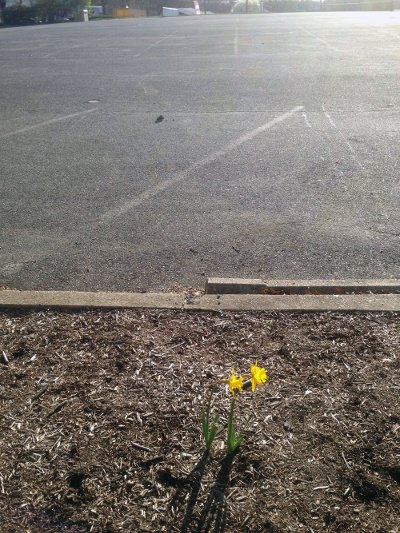
Daffodils planted next to Flower Avenue sidewalk near parking lot bloom 7 months after Placeholders performance (April 12, 2015), Long Branch, Maryland, USA (photograph courtesy Ronit Eisenbach)
Works Cited
Bishop, Claire. Artificial Hells: Participatory Art and the Politics of Spectatorship, London and New York: Verso, 2012. Print.
Bishop, Claire. “The Social Turn- Collaboration and its Discontents.” Artforum 44.6, 2006, 178-183. Print.
Bishop, Claire. “Participation and Spectacle: Where Are We Now?” Living as Form: Socially Engaged Art from 1991-2011. Ed in Nato Thompson. Cambridge: MIT Press, 2012. 35-45. Print.
Chavis, David and McMillan, David. “Sense of community: A definition and theory,” Journal of Community Psychology 14, 1986. 6–23. Print.
Davies, David. Art as Performance. Oxford: Blackwells, 2004.
Dworkin, Craig. No Medium. Cambridge: MIT Press. 2013.
Lombardo, Elena et al. “Questions after the Placeholders Performance | Flower Avenue Festival: A Celebration of Art and Place Long Branch, Maryland, Sept 13, 2014,” (unpublished research conducted by Elena Lombardo, Ronit Eisenbach, Sharon Mansur, and Rafael de Balanzo in partnership with IMPACT Silver Spring, the Long Branch Business League and Montgomery Housing Partnership).
Derrida, Jacques. Trans. Craig Owens. “The Parergon,” October 9. Summer 1979. MIT Press. 3-41. Print.
Duchamp, Marcel. Marcel Duchamp: Notes. Ed. Paul Matisse. Boston: G.K. Hall, 1983. Note 185. Print.
Eisenbach, Ronit. Artist website. Accessed May 4, 2016. <http://roniteisenbach.com>.
Eisenbach, Ronit; Lowry, S; Mansur, Sharon. Discussion following Placeholders. Long Branch neighbourhood of Silver Spring, Maryland. September 13, 2014.
Eisenbach, Ronit and Mansur, Sharon. “Placeholders” (promotional card), 2014.
Eisenbach, Ronit and Mansur, Sharon. “Placeholders in situ: exploring sites-in-transition” Art And Research At The Outermost Limits Of Location-Specificity (conference presentation), November 13 -14, 2014. The Lang Center, School of Art, Media, and Technology at Parsons The New School for Design, a division of The New School, New York NY.
Eisenbach, Ronit and Mansur, Sharon. “Placeholders in situ: exploring sites-in-transition” Project Anywhere: Art at the Outermost Limits of Location Specificity. Accessed May 4, 2016. <http://www.projectanywhere.net/ronit-eisenbach-sharon-mansur-in-situ-exploring-sites-in-transition/>.
Eisenbach, Ronit and Mansur, Sharon. “Placeholders in situ: exploring sites-in-transition” Anywhere. 1. (Project Anywhere, Parsons The New School for Design, and The University of Newcastle (forthcoming).
Geiger, Esther. Placeholders - Observations and Analysis, Unpublished Laban Movement Analysis commissioned by Ronit Eisenbach and Sharon Mansur, November 2014.
Genette, Gérard. Seuils. Paris: Éditions du Seuil, 1987. Translated as Paratexts. Thresholds of interpretation, Cambridge: CUP, 1997. Print
Goldsmith, Kenneth “Language as Material,” Uncreative Writing: Managing Language in the Digital Age. New York: Columbia University Press, 2001, 34-62.
Grigely, Joseph. Exhibition Prosthetics. Bedford Press; Sternberg Press, 2010.
Krauss, Rosalind. A Voyage on the North Sea: Art in the Age of the Post-Medium Condition. London: Thames and Hudson, 2000. Print.
Kukielski, Tina. “Off Pink, The Kitchen, New York, May 8 – May 16, 2015.” accessed April 29, 2015. <http://finearts.parsons.edu/2015mfathesis/artists/tariku-shiferaw/>.
Lefebvre, Henri. The Urban Revolution. Minneapolis: University of Minnesota Press, 2003. Print.
Mansur, Sharon. Quoted in unattributed post: “A time and place: dancers explored the intersection of community and change in Silver Spring”, DBK, Arts, accessed April 30. 2015. <http://m.diamondbackonline.com/diversions/arts/article_9688e8fe-3c63-11e4-957f-001a4bcf6878.html?mode=jqm>
Mansur, Sharon. Artist website. Accessed May 4, 2016. <http://www.mansurdance.com>
Mumford, Lewis “What is a City.” First published in Architectural Record, 1937. The City Reader (Fifth Edition) Eds. Richard T. LeGates and Frederic Stout, London and New York: Routledge, 2011. Print.
Project Anywhere: Art at the Outermost Limits of Location Specificity. Accessed May 4, 2016. <http://www.projectanywhere.net/>
Rancière, Jacques. “The Aesthetic Revolution and Its Outcomes: Employments of Autonomy and Heteronomy,” New Left Review, 14, March–April 2002.
Stein, Morris. “Creativity and Culture.” The Journal of Psychology. 36. 1953. Print.
Strayer, Jeffery. Subjects and Objects: Art, Essentialism, and Abstraction (Philosophy of History and Culture), Brill Academic Pub, 2007.
Taimre, Ilmar. Unpublished Draft of PhD Thesis, School of Creative Arts, The University of Newcastle (forthcoming, 2016).
Tuan, Y. Space and Place: The Perspective of Experience, University of Minnesota, Minneapolis, 1977.

